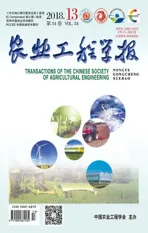基于热平衡分析的地埋管地源热泵换热方案模拟优化
2018-08-10骆祖江杜菁菁
骆祖江,杜菁菁
基于热平衡分析的地埋管地源热泵换热方案模拟优化
骆祖江,杜菁菁
(河海大学地球科学与工程学院,南京 211100)
为了确保丹阳中心城区浅层地热能可持续开发利用,避免丹阳中心城区地埋管地源热泵运行期间出现热堆积问题,基于地下水渗流和热量运移原理,建立了丹阳中心城区地下水非稳定渗流与热量运移三维耦合数值模型,结合未来地埋管地源热泵系统的运行工况,预测丹阳中心城区地下温度场的热平衡发展趋势。在此基础上,规划设计了3种优化方案:①按行政区划Ⅰ~Ⅴ个开发利用分区,调整地埋管间距分别为18,23,17,20,20 m;②地埋管间距5 m,加热秋季生活用水Ⅰ区157 798 m3/d、Ⅱ区413 235 m3/d、Ⅲ区339 322 m3/d、Ⅳ区261 266 m3/d、Ⅴ区27 6205 m3/d,加热春季生活用水Ⅰ区473 394 m3/d、Ⅱ区123 9705 m3/d、Ⅲ区1 017 966 m3/d、Ⅳ区783 798 m3/d、Ⅴ区828 615 m3/d;③地埋管间距5 m,增设冷却塔辅助地埋管换热孔进行夏季排热,冷却塔夏季冷却温度Ⅰ区为4.35 ℃、Ⅱ区为6.12 ℃、Ⅲ区为4.87 ℃、Ⅳ区为5.29 ℃、Ⅴ区为4.80 ℃。3种方案均可以有效减缓和避免丹阳中心城区地埋管地源热泵运行期内的热堆积问题。地下水非稳定渗流与热量运移三维耦合数值模型是优化确定浅层地热能地埋管地源热泵可持续开发利用方案的有效方法。
热泵系统;模型;热平衡;热堆积;浅层地热能
0 引 言
随着城市基础建设的发展,建筑能耗不断增加,浅层地热能凭借其清洁、易开采、储量大等优点受到人们的重视[1-2]。20世纪40、50年代,欧美国家首先兴起了对地源热泵技术的研究;20世纪70年代,第一次能源危机席卷全球,地源热泵技术重新引起人们的关注[3]。地埋管地源热泵(ground-dource heat pump)是地源热泵系统[4-7]的一个分支,是以地表浅层土壤为低品位热源,通过由地下埋管组成的地热换热器与水循环系统输入少量高品位能源,实现热量由低到高的转变,进而实现城市夏季供冷冬季供热的需求[8-11]。进入21世纪以来,中国陆续开展了浅层地热能地埋管地源热泵的开发利用,目前中国地埋管地源热泵系统的应用面积已超过2 000万m2,且每年以超过15%的速度递增[12]。但由于目前尚处于起步阶段,普遍缺乏科学的设计和规划,地源热泵系统在应用过程中相继出现了热堆积问题,严重影响了浅层地热能的可持续开发利用[13-16]。
本文以丹阳中心城区地埋管地源热泵为例,通过建立江苏丹阳中心城区地下水非稳定渗流与热量运移三维耦合数值模型,结合未来地源热泵系统的运行工况,模拟预测了丹阳地下温度场的热平衡发展趋势,在此基础上优化模拟设计了3种不同开发利用方案,即调整地埋管间距[17-19],保持地埋管间距不变增加春秋季生活用水,和保持地埋管间距不变增设冷却塔辅助换热孔排热[20-22],有效解决了地源热泵系统运行过程中的热堆积问题,确保了浅层地热能的可持续开发利用[23]。
1 地质概况
丹阳地处江苏南部,长江南岸,属于北亚热带南部季风气候区,地表水系发达。全市地势西北高、东南低,地处低山丘陵与平原过渡带,地貌以低山丘陵和平原为主,前第四系地层属扬子地层区。本次研究范围为丹阳中心城区,详见图1,图中DW1,DW4,DW6为热响应试验孔,限制深度为100 m。基岩面埋深为30~90 m,包含山前岗地第四系全新世地层、下蜀组、柏山组,太湖冲积平原第四系全新世如东组、更新世滆湖组、昆山组、启东组,岩性以黏土、粉砂为主,少有铁锰质结核。丹阳中心城区缺失第四系上更新统下部的第Ⅰ承压含水层,第四系中、下更新统第Ⅱ、Ⅲ承压含水层。潜水含水层接受大气降水及农田灌溉的补给,由全新统和上更新统上部的褐黄、灰黄色亚黏土和灰、青灰色亚砂土夹粉砂组成,厚度为5~20 m,水位埋深为0.50~4.31 m。
计算区域恒温带深度为10~30 m,钻孔埋深100 m范围内,初始平均温度为18.7~19.26 ℃,岩土体的平均导热系数为1.68~2.07 W/(m·K)。

注:DW1、DW4、DW6为孔号,100为孔深度。
2 地下水非稳定渗流与热量运移模型
2.1 地下水非稳定渗流与热量运移概念模型
以丹阳中心城区为计算区域,垂向上按地层岩性结构由上到下进行概化,共4层,依次为厚度为3~20.4 m的全新世地层、厚度为5.9~44.6 m的晚更新世地层、厚度为6.7~29.4 m的中更新世及厚度为2.2~16.3 m的部分早更新世地层和基岩层,计算深度按换热器长度取100 m。各热储层水平方向上均概化为非均质各向同性,各层水平方向和垂直方向的渗透性相差较大,为水平和垂直2个方向上的各向异性,各层之间均发生水力联系,地下水流态为三维非稳定流。系统顶部为补给边界接受大气降雨的补给,排泄边界为地下水通过系统顶部进行蒸发之处,隔水边界为系统底部。各热储层边界上水力交换密切且其四周均概化为通用水头边界。设定计算范围内地下水和含水介质骨架的热动平衡瞬时完成,忽略由于温度差引起水的密度不同而引起的上下自然对流的影响,并将热储层四周概化为第二类热量边界条件。
2.2 地下水非稳定渗流与热量运移数学模型
取坐标轴方向与热储层各向异性主渗透系数方向一致,可以建立工作区地下水非稳定渗流与热量运移三维耦合数值模型[24-30]。
地下水非稳定渗流数学模型:

式中k、k、k为各向异性主方向渗透系数,m/d;为点(,,)在0时刻的水头值,m;为源汇项,d-1;为时间,d;为计算域;0(,,,0)为点(,,)处的初始水头值,m;(,,)为第二类边界上单位面积的补给量;cos(,),cos(,),cos(,)为流量边界外法线方向与坐标轴方向夹角的余弦;为饱和差(自由面上升)或给水度(自由面下降);2、3为第二类边界和自由面边界。
地下水热量运移数学模型
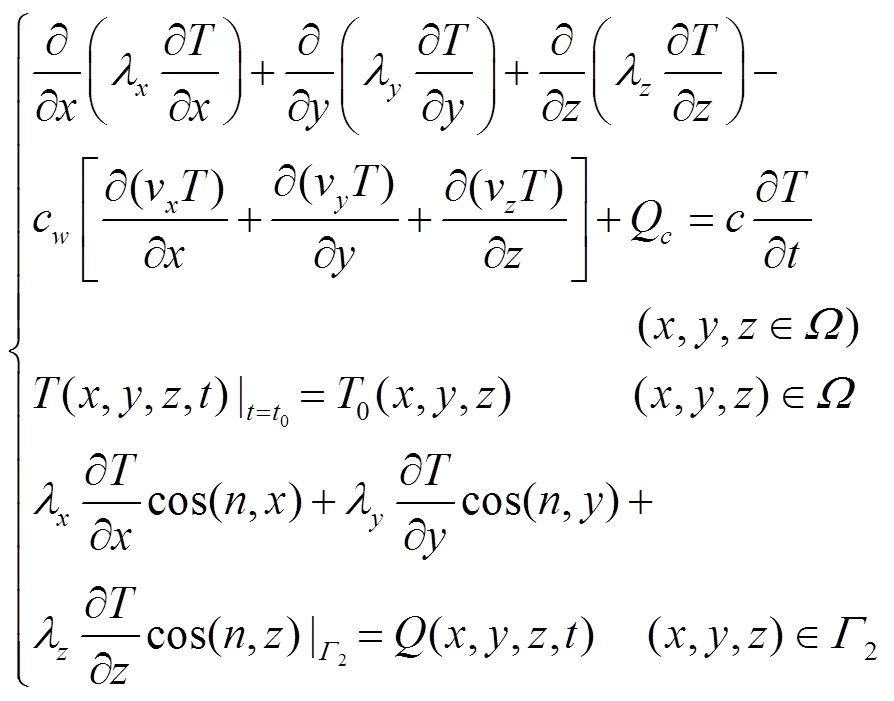
式中、、为各方向水的热动力弥散系数,W/(m·K);c为水的热容量,J/(m3·K);为含水介质的热容量,J/(m3·K);v、v、v为地下水渗流速度分量,m/d;0(,,)为点(,,)处初始温度值,K;(,,,)为边界温度函数;Q为热源汇项Q=cW(T−);T为源汇项的温度,℃;(,,,)为第二类边界上已知的热量或热流函数(J/(m3·d))。
地下水流运动方程:

将式式(1)、(2)、(3)耦合,共同构成地下水非稳定渗流与热量运移三维耦合数值模型。
2.3 模型识别与校正
上述模型采用伽辽金有限元方法进行求解,并采用预处理共轭梯度法求解线性代数方程组。整个计算过程采用FDRTRAN 90语言,按结构化矩阵的设计要求,编制成计算机程序,在PC机加以完成。
平面上将计算域剖分成5 324个三角形单元,每层节点2 764个,垂向上考虑到地层结构和岩性,共剖分为4个地层,5个计算层面,共计21 296个单元,13 820个节点。计算域平面与空间单元剖分见图2。
模型的校正、识别采用热响应试验孔地温监测数据进行温度拟合,其中水文地质参数根据土样渗透系数室内测试统计赋值。根据热响应测试运行期间所取得的地温监测资料,反演土体热物性参数,选取时段2016年3月22日14:00至2016年4月19日5:00作为模型的校正识别时段,共663个应力期,每个应力期一个时间步长。
识别验证阶段采用2016年3月22日14:00各热储层实测温度,作为模型各层的初始温度值;根据地下水位统测资料,确定2016年3月22日14:00各热储层的水位,作为模型各层的初始水位值。

图2 计算域
通过地温监测资料,不断调整参数分区,并进行反演求参,最终将整个计算区分成了30个参数分区,并得到了各分区的参数值,各热储层浅层地热能热物性参数分区见图3,各参数分区的参数值见表1。图4以DW4、DW6为例说明了温度观测值和计算值拟合精度,从图4中可以看出DW4孔温度观测值与计算值的差不超过6 ℃,DW6孔温度观测值与计算值的差不超过2 ℃。
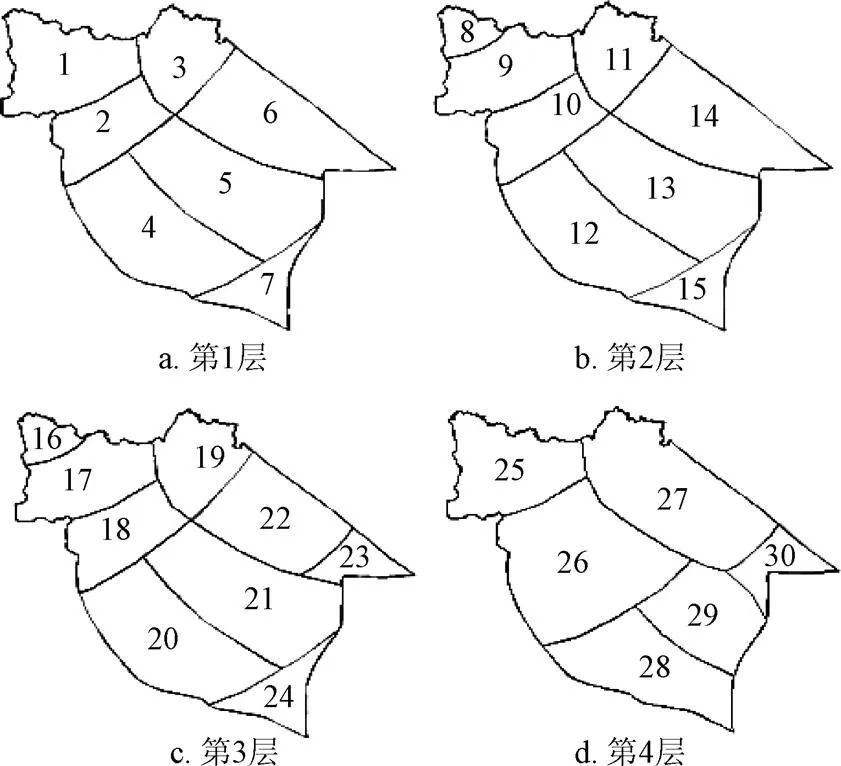
图3 第1~4热储层浅层地热能热物性参数分区
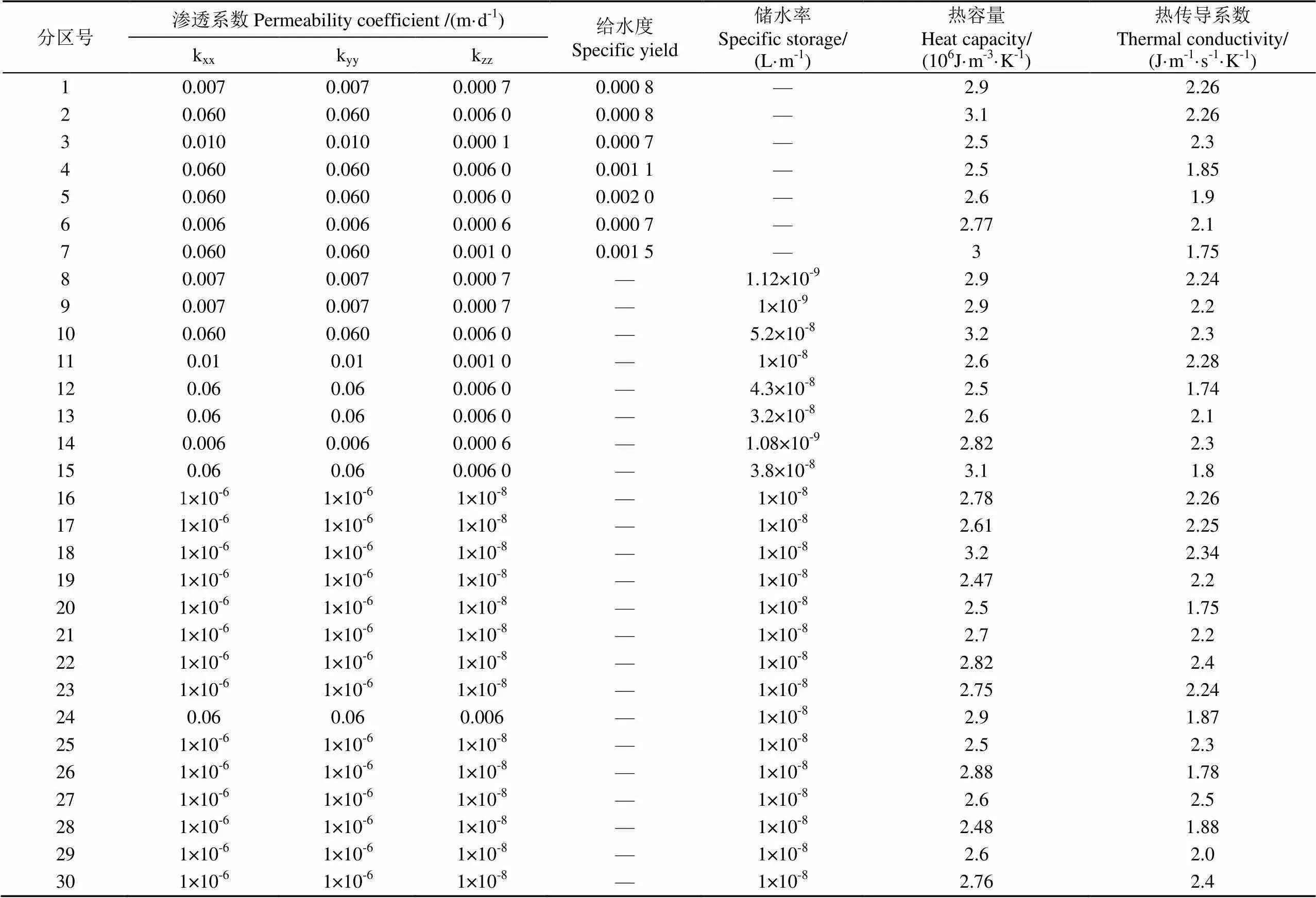
表1 各层位各参数分区表
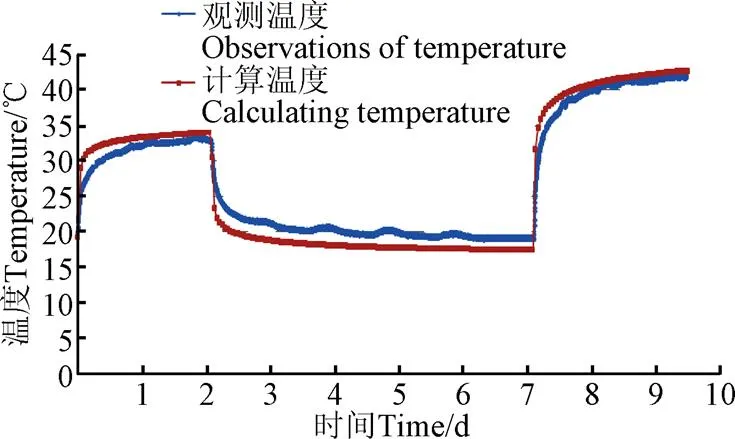
a. DW4
b. DW6
图4 DW6孔温度观测值与计算值拟合图
Fig.4 Temperature observation value and calculated value fitting diagram in DW6
3 热平衡模拟计算
3.1 热平衡发展趋势模拟分析
按行政区将整个丹阳中心城区划分成Ⅰ~Ⅴ个开发利用分区,根据丹阳市实际情况,采取南方典型的冷暖运行模式:冷暖联供模式:每年的6-9月为制冷期(122 d),10-11月为停采期(61 d),12至次年2月为供暖期(90 d),3-5月为停采期(92 d),此为一个运行周期。模拟假设系统运行10 a,且换热系统全天运行10 h,Ⅰ~Ⅴ区井间距均为5 m。
我国山区村镇居民防灾知识相对比较缺乏,要通过防灾宣传教育,使人们掌握应对各种地质灾害的防灾知识,提高自救能力。对泥石流来说,应懂得:不要停留或躲在屋里;露宿时避开陡峭的悬崖和沟壑;逃生时往旁侧面跑,跑到开阔地带或坚固的高地上;山谷中出现巨大沉闷的响声、沟槽断流和沟水变浑等现象,预示可能发生泥石流。
在上述工况下,预测地埋管换热方式浅层地热能开采运行10 a地下水渗流与热量运移的变化趋势。预测时间段为2015年6月初至2025年5月底,每年12个应力期,每个应力期一个时间步长。初始温度场等值线图及运行10 a温度场等值线图见图5、图6,以Ⅲ区DW6孔为例,运行10 a该监测孔处地温历时曲线见图7,各监控点处的温度变化值见表2。
表2 监控点温度变化值 Table 2 Temperature change value 计算分区Partition地埋管间距Spacing of buried pipe/m监控点编号Monitory point no.地层温度增幅Formation temperature increase/℃均值Mean value/℃ Ⅰ区512.776.90 211.03 Ⅱ区5312.2510.24 48.22 Ⅲ区5511.8411.64 611.45 Ⅳ区575.397.44 89.50 Ⅴ区598.386.71 105.03
图5 2015年6月1日模型第1~4层初始温度场图 Fig.5 Natural temperature field map of 1-4 layer in Jun 1, 2015
图6 2025年5月31日第1~4层预测温度场图 Fig.6 Forecast temperature field map of 1-4layer in May 31, 2025
图7 DW6监测孔处运行10 a的地温历时曲线 Fig.7 Earth temperature diachronic curve of DW6 after operating 10 years
由于地埋管换热方式浅层地热能的开发,随着换热孔夏季放热冬季取热,温度在局部范围内将发生较大变化,热量逐年堆积。由此将对周围水环境产生一系列的影响,也将造成地埋管换热系统在第一个运行季节的中期或是后期换热效果减弱,换热系统能效降低甚至无法正常运行。
3.2 地埋管换热方式优化模拟分析
由运行方案预测结果可知,由于地埋管间距过近,浅层地热能开发引起热量堆积在地下难以消耗,随时间推移,热堆积越来越严重。
为实现浅层地热能的可持续开发利用,应用所建立的研究区地下水非稳定渗流与热量运移三维耦合数值模型,分3种方案进行优化模拟分析,讨论3种方案减缓热量堆积的程度:方案1当各计算分区单孔年内取放热量确定时,运行工况不变,针对热堆积问题,模拟计算各分区浅层地热能开发利用的最小地埋管间距;方案2当各计算分区地埋管间距为5 m、单孔年内取放热量确定时,适当改变运行工况,针对热堆积问题,模拟计算春秋季需加热生活用水的水量;方案3当各计算分区地埋管间距为5 m、单孔年内取放热量确定时,增加冷却塔辅助设备,针对热堆积问题,模拟计算夏季循环介质经冷却塔需冷却的温度。
3.2.1 方案1模拟结果与分析
研究数据选取科睿唯安公司的德温特数据库;检索时间为2018 年7月;检索方式利用“关键词”+“IPC分类号”进行组合检索;检索范围为1963年至今与自动驾驶技术相关的所有专利数据;检索初步结果为相关专利共计22 184条,经查重、清洗得到最终有效专利22 177条。
赵新宇等(2013)利用吉林大学公众幸福指数课题组关于2012年中国公众主观幸福感问卷调查数据,运用有序概率模型考察了绝对收入、相对收入和预期对公众主观幸福感的影响。发现我国存在“幸福悖论”现象,相对收入对公众主观幸福感有显著促进作用,其效果强于绝对收入;预期对于中、低收入群体的主观幸福感具有显著正向作用。
方案1通过模拟计算,将Ⅰ~Ⅴ区的最小地埋管间距改变为18、23、17、20、20 m,各监控点10 a后100 m以上浅地层平均温度增幅及可开采资源量见表3,DW6孔处运行10 a的温度历时曲线见图8。
表3 方案1监控点温度变化及可开采资源量 Table 3 Temperature change value and recoverable resources in scheme 1 计算分区Partition地埋管间距Spacing of buried pipe/m监控点编号Monitory point No.地层温度增幅Formation temperature increase/℃均值Mean value/℃夏季总排热量Total summer heat /kW冬季总取热量Total winter heat/kW Ⅰ区1810.490.4837 355.2933 187.23 20.47 Ⅱ区2330.480.4445 829.0134 421.35 40.40 Ⅲ区1750.460.4755 537.8446 883.83 60.49 Ⅳ区2070.410.4354 658.9544 335.95 80.45 Ⅴ区2090.460.4261 665.9252 484.28 100.38
图8 方案1下DW6孔运行10 a的温度历时曲线 Fig.8 Earth temperature diachronic curve of DW6 in scheme 1 after operating 10 years
由计算结果可知,地埋管浅层地热能开采10 a后,由于地埋管间距增加,年内地层温度升幅减小;由监控点多年历时曲线图可知,制冷期内监控点处土壤温度逐渐上升,供热期内监控点处土壤温度逐渐下降,随着浅层地热能的开发利用,土壤温度呈缓慢上升的趋势,且10 a内各点处升温均不超过0.5 ℃,热堆积问题得到有效缓解。
3.2.2 方案2模拟结果与分析
已知Ⅰ~Ⅴ区需加热生活用水的总面积为173.23 km2,对各计算分区单孔换热量分别按5%损失计算,将生活用水从15 ℃加热到50 ℃,获得各区加热生活用水量详见表4。通过模拟计算,保持地埋管地埋管间距为5 m,增加春秋季加热生活用水1 447 826.19 m3/d的运行方案下,热堆积问题得到缓解。各监控点10 a后100 m以上浅地层平均温度增幅见表5,浅层地热能可开采资源量见表6,DW6孔处运行10 a的温度历时曲线见图9。
表4 方案2春秋季各区加热生活用水量 Table 4 Heating water consumption in each district in spring and autumn in scheme 2 运行时间Running time加热水量Heating water consumption /(m3·d-1) Ⅰ区Ⅱ区Ⅲ区Ⅳ区Ⅴ区合计Total 秋季Autumn11月157 798413 235339 322261 266276 2051 447 826 春季Spring3月157 798413 235339 322261 266276 2051 447 826 4月157 798413 235339 322261 266276 2051 447 826 5月157 798413 235339 322261 266276 2051 447 826
表5 方案2监控点温度变化值 Table 5 Temperature change values of observe points in sheme 2 计算分区Partition地埋管间距Spacing of buried pipe/m监控点编号Monitory point No.地层温度增幅Formation temperature increase/℃均值Mean value/℃ Ⅰ区510.140.26 20.39 Ⅱ区530.360.31 40.25 Ⅲ区550.330.29 60.25 Ⅳ区570.220.27 80.32 Ⅴ区590.280.23 100.17
表6 方案2浅层地热能可开采资源量 Table 6 Shallow geothermal energy recoverable resources in scheme 2 计算分区Partition面积Proportion/km2夏季总排热量Total summer heat discharge/kW秋季总取热量Total autumn heat absorption/kW冬季总取热量Total winter heat absorption/ kW春季总取热量Total spring heat absorption/ kW Ⅰ区24.34484 311.6760 255.45430 174.1260 255.45 Ⅱ区41.78809 232.13159 761.57605 509.36159 761.57 Ⅲ区36.33889 268.92130 489.79750 238.68130 489.79 Ⅳ区36.53631 064.91100 121.91512 168.62100 121.91 Ⅴ区34.25712 711.50105 606.96606 147.68105 606.96 合计Total173.233 526 589.13556 235.692 904 238.45556 235.69
图9 DW6孔运行10 a的温度历时曲线 Fig.9 Earth temperature diachronic curve of DW6 after operating 10 years
从计算结果可知,地埋管换热方式浅层地热能开采10 a后,由于增加春秋季加热生活用水,年内地层温度几乎无增幅;由监控点温度多年历时曲线图9可知,夏季制冷期内监控点处土壤温度逐年上升,秋季、冬季、春季供热期内监控点处土壤温度逐渐下降,随着浅层地热能的开发利用,土壤温度呈缓慢上升的趋势,且10 a内各点处的温度上升平均不超过0.5 ℃,热堆积问题得到有效缓解。
测试设备使用了超宽带厘米波设备,具有成本低、辐射小和便于推广的特点.实验结果验证可以准确识别介电常数差别较大的液体危险品,如汽油和水.算法为微波检测液体危险品提供了一个新的研究方向.算法存在对介电常数相似的样品识别率低、散射曲线平滑程度特征散布较大这两个难点,今后将从分析样本的分布、改进训练算法、隔离外部干扰源等方面做进一步研究.
本文选取国际原油市场比较有代表性的WTI原油现货价格与1月、2月、3月和4月期的期货价格的月度数据为研究对象,为消除时间序列可能存在的异方差,对现货价格和期货价格取自然对数,分别用lnS、lnF(1)、lnF(2)、lnF(3)和lnF(4)表示,数据来源于国际能源信息署,所使用的样本数据的时间跨度为1986年1月到2013年5月,共329个观测。对相应合约在某个给定日并无交易的情形,遵循Alquist和Kilian(2010)的方法,将最接近月度最后一个交易日的相应期货价格作为其月度值。表1给出WTI现货与期货的描述性统计量和单位根检验结果。
3.2.3 方案3模拟结果与分析
将冷却塔与换热孔共同作为冷却源供机组运行,经过冷却塔冷却的水,进入地埋管换热器,降低了换热器的冷凝温度,实现两者的互补,提高整个系统的运行效率。保持地埋管间距5 m、冷却塔与地埋管换热孔数量一致,冷却塔在6~8月开机,并且与地埋管换热器每日同时运行10 h的工况下,忽略换热器与地下埋管之间管路的热量损失。根据岩土体现场热响应试验及地温监测资料,夏季的换热温差一般为13.24~14.27 ℃,冬季的换热温差一般为10.73~11.76 ℃;根据《江苏省地源热泵工程技术规程》(DGJ32/TJ89-2009),地源热泵系统的制冷工况:空调侧出水温度为7~12 ℃,冷却水温差为5 ℃,因此Ⅰ~Ⅴ区夏季各区地埋管及冷却塔冷却水温详见表7。各监控点10 a后100 m以上浅地层平均温度增幅及可开采资源量见表8,DW6孔处运行10 a的温度历时曲线见图10。
表7 方案3下Ⅰ~Ⅴ区地埋管及冷却塔冷却水温 Table7 Cooling water temperature of buried pipe and cooling tower in Ⅰ~Ⅴarea in scheme 3 分区编号Number分区面积Proportion/km2换热温差夏季Summer heat exchange temperature difference/℃换热温差冬季Winter heat exchange temperature difference /℃冷却塔夏季冷却温度Cooling tower summer cooling temperature/℃ Ⅰ区24.3413.2411.764.35 Ⅱ区41.7814.2710.736.12 Ⅲ区36.3313.5611.444.87 Ⅳ区36.5313.8011.205.29 Ⅴ区34.2513.5111.494.80 合计Total173.23———
图10 方案3下DW6孔运行10 a温度历时曲线 Fig.10 Earth temperature diachronic curve of DW6 after operating 10 years in scheme 3
表8 方案3监控点温度变化及可开采资源量 Table 8 Temperature change value and recoverable resources in scheme 3 计算分区Partition地埋管间距Spacing of buried pipe/m监控点编号Monitory point no.地层温度增幅Formation temperature increase/℃均值Mean value/℃夏季总排热量Total summer heat discharge/kW冷却塔夏季总散热量Summer total heat dissipation of cooling tower/kW冬季总取热量Total winter heat absorption /kW Ⅰ区510.230.32484 311.67159 200.40430 237.27 20.41 Ⅱ区530.320.26809 232.13348 168.73607 176.35 40.20 Ⅲ区550.310.31889 268.92319 667.45750 197.07 60.31 Ⅳ区570.220.26631 064.91241 990.93512 153.66 80.30 Ⅴ区590.310.24712 711.50253 016.90606 176.37 100.18
由计算结果可知,地埋管换热方式浅层地热能开采10 a后,由于采用冷却塔与地埋管混合式换热系统,弥补了地埋管单独排热导致热堆积的缺陷,保证温度有较好的恢复,10 a内地层温度几乎无增幅;由监控点温度多年历时曲线图10可知,夏季制冷期内监控点处土壤温度逐渐上升,冬季供暖期内监控点处土壤温度逐渐下降,随着浅层地热能的开发利用,土壤温度呈缓慢上升的趋势,且10 a内各点处温度上升平均不超过0.5 ℃,热堆积问题得到有效缓解。
这类现象还有很多,比如 “闭月羞花”中的“闭”和“羞”、“打草惊蛇”中的“惊”、“楚楚动人”中的“动” 、“惊心动魄”中的“惊”和“动”、“感人肺腑”中的“感”、“翻江倒海”中的“翻”和“倒”、“除旧布新”中的“除”和“布”都用作使动。
3.3 结果分析
从上述模拟计算结果可以看出,研究区如不加辅助设施,采用5 m的地埋管间距开采浅层地热能会导致热堆积问题,严重影响浅层地热能的可持续开发利用,必须增大地埋管的间距,Ⅰ~Ⅴ开发利用分区的地埋管间距分别要增至18,23,17,20,20 m,才能避免热堆积问题,实现浅层地热能的可持续开发利用。
但在实际开发利用过程中会受到开发利用场地条件的限制,无法采取大间距的地埋管方式来实现浅层地热能的可持续开发利用。目前江苏南部地区常用的地埋管间距一般为5 m左右,因此研究区要实行浅层地热能的可持续开发利用必须在地埋管间距5 m的基础上,增加辅助设施,如方案2、3采用加热春秋季生活用水或增设地面冷却塔的办法来消除热堆积问题,实现浅层地热能的可持续开发利用。
4 结 论
1)基于地下水渗流与热泵运移原理建立的地下水非稳定渗流和热量运移模型,可以准确模拟预测地埋管地源热泵三维耦合数值模型系统不同工况运移过程中的热平衡发展趋势,确定出浅层地热能的可持续性开发利用方案。
2)进行地埋管换热方式浅层地热能开发时,换热系统夏季开机122 d、冬季开机90 d、每天运行10 h,选取Ⅰ~Ⅴ区地埋管间距分别为18,23,17,20,20 m,可以有效缓解地温场热堆积问题。
2)裂缝宽度大于0.3mm的环向裂缝,属结构受力裂缝。但隧道结构为拱形截面受力,此类裂缝不影响结构的安全性,采用环氧树脂浆抹面封闭,渗漏严重的,先排水后封闭处理即可。
3)进行地埋管换热方式浅层地热能开发时,保持地埋管间距为5 m,春季、秋季分别对生活用水加热92、31 d,每天运行10 h,将生活用水从15 ℃加热到50 ℃,可以有效缓解地温场热堆积问题。
4)进行浅层地热能开发时,地埋管换热方式为保持地埋管间距5 m,换热系统夏季开机122 d、冬季开机90 d、每天运行10 h,冷却塔夏季开机122 d、每天运行10 h,可以有效缓解地温场热堆积问题。
[参 考 文 献]
[1] 张甫仁,彭清元,朱方圆,等. 重庆主城区浅层地温能资源量评价研究[J]. 中国地质,2013,40(3):974-980.
Zhang Furen, Peng Qingyuan, Zhu Fangyuan, et al. The evaluation of shallow geothermal energy resources in Chongqing[J]. Geology in China, 2013, 40(3): 974-980. (in Chinese with English abstract)
[2] 柴立龙,马承伟,张义. 北京地区温室地源热泵供暖能耗及经济性分析[J]. 农业工程学报,2010,26(3):249-254.
Chai Lilong, Ma Chengwei, Zhang Yi, et al. Energy consumption and economic analysis of ground source heat pump used in greenhouse in Beijing[J]. Transactions of the Chinese Society of Agricultural Engineering (Transactions of the CSAE), 2010, 26(3): 249-254. (in Chinese with English abstract)
[3] 骆祖江,李伟,王琰,等. 地下水源热泵系统热平衡模拟三维数值模型[J]. 农业工程学报,2014,30(2):198-204.
Luo Zujiang, Li Wei, Wang Yan, et al. Three-dimensional numerical model for heat balance simulation of groundwater heat pump[J]. Transactions of the Chinese Society of Agricultural Engineering (Transactions of the CSAE), 2014, 30(2): 198-204. (in Chinese with English abstract)
[4] 胡金强. 地源热泵系统热平衡分析及其在大型公共建筑中的应用[J]. 制冷技术,2015,35(2):63-67.
Hu Jinqiang. Analysis of heat balance in ground source heat pump system and its application in large scale public buildings[J]. Chinese Journal of Refrigeration Technology, 2015, 35(2): 63-67. (in Chinese with English abstract)
[5] John W Lund, Derek H Freeston, Tonya L Boyd. Direct utilization of geothermal energy 2010 worldwide review[J]. Transactions of the Chinese Society of Agricultural Engineering (Transactions of the CSAE), 2011, 40(3): 159-180. (in Chinese with English abstract)
[6] 田良河,闫震鹏,刘新号. 郑州市地下水源热泵适宜区浅层地热能资源量评价[J]. 城市地质,2011,6(3):12-16.
Tian Lianghe, Yan Zhenpeng, Liu Xinhao. The shallow geothermal energy resource evaluation on the suitable area of groundwater source heat pump in Zhengzhou city[J]. City Geology, 2011, 6(3): 12-16. (in Chinese with English abstract)
[7] Pike Christopher, Whitney Erin. Heat pump technology: An Alaska case study[J].Journal of Renewable and Sustainable Energy, 2017, 9(6)
[8] 岳高凡,赵紫威,王婉丽,等. 地源热泵系统对土壤温度场影响的数值模拟研究——以北京某场地为例[J]. 中国科技论文,2017,9(12):1049-1053.
Yue Gaofan, Zhao Ziwei, Wang Wanli, et al. Numerical simulation study on soil temperature field influenced by GSHP: A case study in Beijing[J]. China Science Paper, 2017, 9(12): 1049-1053. (in Chinese with English abstract)
[9] 徐伟,刘志坚. 中国地源热泵技术发展与展望[J]. 建筑科学,2013,29 (10):26-33.
Xu Wei, Liu Zhijian. Development and prospect of ground source heat pump technology in China[J]. Building Science, 2013, 29 (10): 26-33. (in Chinese with English abstract)
[10] 骆祖江,徐晓,常晓军. 基于Monte-Carlo参数模拟的体积法评价浅层地热能资源[J]. 勘查科学技术,2017(6):15-22.
Luo Zujiang, Xu Xiao, Chang Xiaojun. Evaluation of shallowgeothermal energy resources based on Monte-Carlo parameter simulation in volume method[J]. Site Investigation Science and Technology, 2017(6): 15-22. (in Chinese with English abstract)
[11] 岳丽燕,孟令军,赵苏民,等. 天津市浅层地热能存在的热堆积问题及解决方法探讨[J]. 地质调查与研究,2017,40 (1):76-80.
Yue Liyan, Meng Lingjun, Zhao Sumin, et al. The cold & heat accumulation problem and solution methods of the shallow geothermal resource in Tianjin[J]. Geological Survey and Research, 2017, 40(1): 76-80. (in Chinese with English abstract)
[12] 方慧,杨其长,孙骥. 地源热泵—地板散热系统在温室冬季供暖中的应用[J]. 农业工程学报,2008,24(12):145-149.
Fang Hui, Yang Qichang, Sun Ji. Application of ground-source heat pump and floor heating system to greenhouse heating in winter[J]. Transactions of the Chinese Society of Agricultural Engineering (Transactions of the CSAE), 2008, 24(12): 145-149. (in Chinese with English abstract)
[13] 龙西亭,袁瑞强,皮建高,等. 长沙浅层地热能资源调查与评价[J]. 自然资源学报,2016,31(1):163-176.
Long Xiting, Yuan Ruiqiang, Pi Jiangao, et al. Survey and evaluation of shallow geothermal energy in Changsha[J]. Journal of Natural Resources, 2016, 31(1): 163-176. (in Chinese with English abstract)
[14] Barbier E. Geothermal energy technology and current status: Aan overview[J]. Renewable & Sustainable Energy Reviews, 2002, 6(1/2): 3-65.
[15] Hettiarachchia H D Madhawa, Golubovica Mihajlo, Worek William M, et al. Optimum design criteria for an organic Rankine cycle using low-temperature geothermal heat source[J]. Energy, 2007, 32(9): 1698-1706.
[16] 张远东,万育生. 我国地下水源热泵应用现状和监管措施探讨[J]. 水资源管理,2009(21):39-41.
Zhang Yuandong, Wan Yusheng. Current status of groundwater source heat pump utilization in China and supervisory suggestions[J]. China Water Resources, 2009(21): 39-41. (in Chinese with English abstract)
[17] 胡继华,张延军,于子望,等. 水源热泵系统中地下水流贯通及其对温度场的影响[J]. 吉林大学学报:地球科学版,2008,38(6):992-998.
Hu Jihua, Zhang Yanjun, Yu Ziwang, et al. Groundwater flow transfixion of groundwater source heatpump system and its influence on temperature field[J]. Journal of Jilin University: Earth Science Edition, 2008, 38(6): 992-998. (in Chinese with English abstract)
[18] 徐贵来,刘红卫,张晴,等. 地下水源热泵系统运行期间岩土层温度变化规律研究[J]. 资源环境与工程,2010,24(2):180-184.
Xu Guilai, Liu Hongwei, Zhang Qing, et al. Geotemperature changes in rock and soil stratum during groundwater source heat pump system operation[J]. Resources Environment and Engineering, 2010, 24(2): 180-184. (in Chinese with English abstract)
[19] Hepbasli A. Energy and exergy analysis of a ground source (geothermal) heat pump system[J]. Transactions of the Chinese Society of Agricultural Engineering (Transactions of the CSAE), 2004, 45(5): 737-753. (in Chinese with English abstract)
[20] Lim K B, Lee S H, Lee C H. Application of ground-heat- source water thermal-storage with a heat-pump cooling and heating system[J]. Proceedings of the Institution of Mechanical E-journal of Process Mechanical Engineering, 2010, 224(E1): 73-78.
[21] Paksoy H O, Anderson O, Abaci S, et al. Heating and cooling of a hospital using solar energy coupled with seasonal thermal energy storage in an aquifer[J]. Renewable Energy, 2000, 19(1): 117-122.
[22] Camdali U, Tuncel E. An Economic Analysis of Horizontal Ground Source Heat Pumps (GSHPs) For Use in Heating and Cooling in Bolu, Turkey[J].Energy Sources Part B-Economics Planning and Policy, 2013, 8(3): 290-303.
[23] Kavanaugh S. Simple, efficient, reliable - Ground source heat pumps[J]. Ashrae journal-American Society of Heating Refrigerating and Air-conditioning Engineers, 1998, 40(10): 31.
[24] 杨卫波,施明恒. 地源热泵中U型埋管传热过程的数值模拟[J]. 东南大学学报:自然科学版,2007,37(1):78-83.
Yang Weibo, Shi Mingheng. Numerical simulation on heat transfer process in U-bend ground heat exchanger of ground source heat pump[J]. Journal of Southeast University: Natural Science Edition, 2007, 37(1): 78-83. (in Chinese with English abstract)
[25] Luo Z, Wang Y, Zhou S, et al. Simulation and prediction of conditions for effective development of shallow geothermal energy[J]. Applied Thermal Engineering, 2015, 91: 370-376.
[26] Ren Xiaohong, Sun Chunwu, Hu Yanhui. A three- dimensional numerical model and experimental research for U-tube ground heat exchanger in heating operation[J]. Journal of Chongqing Jianzhu University, 2004, 26(5): 90-95.
[27] 周彦章,周志芳,傅志敏. 地源热泵系统可持续运行地下水热量运移模拟[J]. 东南大学学报:自然科学版,2009,39(增刊):297-303.
Zhou Yanzhang, Zhou Zhifang, Fu Zhimin. Simulation of thermal transport in aquifer for the sustainable running of GWHP system[J]. Journal of Southeast University: Natural Science Edition, 2009, 39(Supp.): 297-303. (in Chinese with English abstract)
[28] 朱小波,李幽铮,周彦章. 地源热泵系统冷负荷设计方案变化地下水热量运移模拟[J]. 勘察科学技术,2010(5):13-17.
Zhu Xiaobo, Li Youzheng, Zhou Yanzhang. Simulation of groundwater thermal migration for GWHP system[J]. Site Investigation Science and Technology, 2010(5): 13-17. (in Chinese with English abstract)
[29] 靳萍,邵景力,李长青,等. 基于T-PROGS的地下水三维数值模拟及应用[J]. 水文地质工程地质,2009,36(4):21-26.
Jin Ping, Shao Jingli, Li Changqing, et al. Application of T-PROGS to a 3-D numerical simulation of groundwater flow[J]. Hydrogeology & Engineering Geology, 2009, 36(4): 21-26. (in Chinese with English abstract)
[30] Berthier L, Garrahan J P. Numerical study of a fragile three-dimensional kinetically constrained model[J]. Journal of Physical Chemistry B, 2005, 109(14): 6916.
Heat exchange scheme simulation optimization for ground source heat pump system with buried pipes by thermal equilibrium analysis
Luo Zujiang, Du Jingjing
(School of Earth Science and Engineering, Hohai University, Nanjing 211100, China)
Abstract: Since the 21st century, the development and utilization of ground source heat pump in shallow geothermal energy is carried out in China successively. But it is still in its infancy, and there is a general lack of scientific design and planning, the problem of heat accumulation occurred in the process of application of ground source heat pump system, seriously affecting the sustainable development and utilization of shallow geothermal energy. In order to guarantee shallow geothermal energy sustainable development and utilization and avoid the problem of heat accumulation during the running period of ground-source heat pump in the downtown of Danyang, a three-dimensional coupled numerical model of groundwater unsteady seepage and heat transfer was established and applied to the demonstration project of the buried pipe heat pump system in Danyang, Jiangsu Province. The model was based on the principle of groundwater seepage and heat transport, combined with future ground-source heat pump system operating conditions, forecasting the thermal equilibrium development trend of underground temperature field. Three schemes were designed on this basis. Scheme 1 is to adjust heat transfer hole spacing. By simulation and calculation, we changed the minimum heat transfer 5 m hole spacing to 18, 23,17, 20, 20 m inⅠ-Ⅴarea respectively, and results showed that due to the increase of heat transfer hole spacing through mining buried pipe shallow geothermal energy for ten years, the rise in formation temperature decreased. Scheme 2 is to keep the heat exchange hole spacing constant, and heating spring and autumn living water. The total area of heating domestic water in study area was 173.23 km2, single hole heat exchange was calculated with 5% heat loss and heating water from 15 to 50 ℃. By the simulation and calculation, keeping 5 m transfer hole spacing, the heating water amount reach 1 447 826.19 m3/d in spring and autumn with the development and utilization of shallow geothermal energy. Mining 10 years, due to increasing heating water in spring and autumn, there is little increase in formation temperature during the year. The temperature of soil in winter, autumn and spring increases slowly, the problem of heat accumulation is alleviated. Scheme 3 is to keep the heat exchange hole spacing constant and add the cooling tower auxiliary heat exchange hole for summer heat discharge. The cooling tower is in accordance with the number of heat exchange holes in buried pipes and keeping 5 m transfer hole spacing, running 10 hours a day, let water through cooling towers of different cooling temperatures. Mining 10 years, the mixed heat transfer system with cooling tower and buried pipe can eliminate the heat accumulation caused by separate buried pipe system, ensure a good temperature recovery. Due to the limit of ground source heat pump engineering site, Scheme 1 can’t be used, heating water in spring and autumn or adding cooling tower auxiliary heat exchange hole for summer heat discharge can be adopted in the actual project. The three-dimensional coupled numerical model of groundwater unsteady seepage and heat pump is an effective way to optimize and determine the sustainable development and utilization plan of ground source heat pump for shallow geothermal energy.
Keywords: heat pump systems; models; heat balance; heat accumulation; shallow geothermal energy
骆祖江,杜菁菁. 基于热平衡分析的地埋管地源热泵换热方案模拟优化[J]. 农业工程学报,2018,34(13):246-254. doi:10.11975/j.issn.1002-6819.2018.13.030 http://www.tcsae.org
Luo Zujiang, Du Jingjing. Heat exchange scheme simulation optimization for ground source heat pump system with buried pipes by thermal equilibrium analysis[J]. Transactions of the Chinese Society of Agricultural Engineering (Transactions of the CSAE), 2018, 34(13): 246-254. (in Chinese with English abstract) doi:10.11975/j.issn.1002-6819.2018.13.030 http://www.tcsae.org
收稿日期:2018-02-27
修订日期:2018-05-31
基金项目:中国地质调查局江苏省合作项目(12120114023101)
作者简介:骆祖江,博士,教授,博士生导师,主要从事水文地质等方面研究与教学工作。Email:luozujiang@ sina.com
doi:10.11975/j.issn.1002-6819.2018.13.030
中图分类号:TU111; TK52
文献标志码:A
文章编号:1002-6819(2018)-13-0246-09
